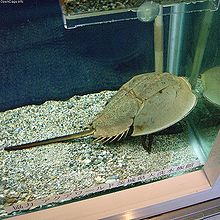Tachypleus tridentatus
| Tachypleus tridentatus | |
|---|---|
 |
|
| Scientific classification | |
| Kingdom: | Animalia |
| Phylum: | Arthropoda |
| Class: | Merostomata |
| Order: | Xiphosura |
| Family: | Limulidae |
| Genus: | Tachypleus |
| Species: | T. tridentatus |
| Binomial name | |
|
Tachypleus tridentatus (Leach, 1819) |
|
Tachypleus tridentatus, commonly known as the Chinese, Japanese, or tri-spine horseshoe crab, is a species of horseshoe crab found in the seas off China, Indonesia, Japan, South Korea, Malaysia, the Philippines, Taiwan, and Vietnam.
Horseshoe crabs are not crabs at all, but are most closely related to spiders, scorpions and trilobites. The tri-spine horseshoe crab is so-named because of the three large spiny processes on either side of the carapace. The cephalothorax is protected by this single large, horseshoe-shaped plate, and neither it nor the abdomen is visibly segmented. The tail bears a long spike.
Like other species of horseshoe crabs, T. tridentatus is an omnivore and feeds on molluscs, worms, other benthic invertebrates and algae. Large batches of eggs are laid in holes dug in sandy beaches in special nursery areas off the coast. On hatching, the larvae remain in the nest over winter, feeding on the yolks of their eggs for several months, remaining in this nursery area during the next spring and summer. As juveniles they remain buried in the sediment during high tide, emerging at low tide to feed on the exposed surface. They have limited opportunities to disperse widely. Adults move offshore for the winter, hibernating buried in the seabed at depths of around 20 metres (66 ft), coming inshore again when the water warms up the following year. As a poikilotherm, this horseshoe crab is much affected by rising seawater temperatures, reacting by burying itself deeply in the sediment and sometimes going into diapause.
The tri-spine horseshoe crab are at risk from over-fishing, pollution and the loss of their breeding grounds. Populations have declined for decades, and the species was granted protection in Japan in 1928. In China it has become less common and, from being once abundant in Taiwan, it is now seldom seen inshore there. The International Union for Conservation of Nature does not have enough available information to make an assessment of its conservation status and has rated it "data deficient".
...
Wikipedia

